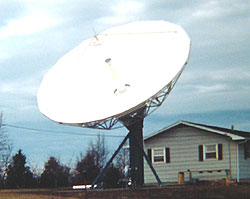 In 1981 our company began distributing our (news and ag) programs to radio stations via satellite. It was a big deal at the time because we were the first of the smaller, regional networks to “go satellite.” Uplink hardware was damned expensive. Downlink hardware at the radio stations was pretty pricey, too. But much cheaper (in the long run) than all of those point-to-point land lines.
In 1981 our company began distributing our (news and ag) programs to radio stations via satellite. It was a big deal at the time because we were the first of the smaller, regional networks to “go satellite.” Uplink hardware was damned expensive. Downlink hardware at the radio stations was pretty pricey, too. But much cheaper (in the long run) than all of those point-to-point land lines.
For many years, having a satellite distribution system was a competitive edge. You had to have some way of getting the programming to the radio stations (and their listeners). No FedEx in those days.
In a few weeks, football season will get underway and we’ll be distributing play-by-play audio to affiliates of 35 collegiate sports radio networks around the country. Most of those via satellite. But for the first time, we’ll use live web streaming to deliver audio to the affiliates of two of our networks (Maine and Montana State).
This is possible because of increased bandwidth; better audio encoding; and a growing acceptance of audio (and video) online. If all goes according to plan, listeners won’t even be aware of how the audio gets from the stadium to their radios (or computers).
We could sort of see this coming but it was/is difficult to imagine a time when satellite distribution of audio and video could be replaced by the Internet (or even some Super Internet of the future). But it’s getting easier.
So what’s it all mean? It seems unlikely your “competitive edge” will be distribution. That’s probably been true for some time now. Having the good content will always be important. But if you are not the only source for the content… or the best source for the content… (to be continued).

 In 1981 our company began distributing our (news and ag) programs to radio stations via satellite. It was
In 1981 our company began distributing our (news and ag) programs to radio stations via satellite. It was